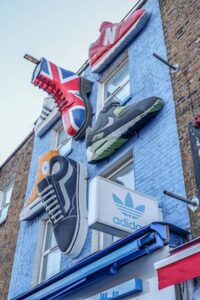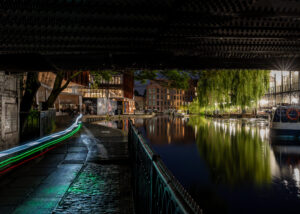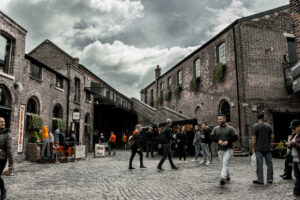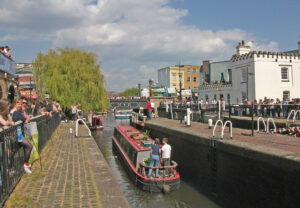The Unknown History of Camden Market
Date post added: 10th April 2024
A trip to Camden Market to buy a pair of Dr. Martens and some tie-dye is a rite of passage for many British teenagers. But it hasn’t always been a retail destination for lovers of alternative independent stores and market stalls or vibrant music venues and cafes. Yes, there’s far more to cool Camden Town than rummaging through vintage clothing stores, hanging out at Dingwall’s or paying homage to the late, great Amy Winehouse (she has a statue on Chalk Farm Road).
The North London district of Camden is neighboured by Hampstead, Highgate, Primrose Hill and Islington with the West End within easy reach. This popular tourist destination actually has a rich industrial history centred around transportation – by rail, barge and horse. So, what is the history of Camden Market and how did it all begin?
10 Lesser Known Factors in the History of Camden Market
1. The end of the rail line means a new beginning
Before there was a Northern Line delivering throngs of people to Camden Town tube station, there were barges, horses, and importantly steam trains.
With the Industrial Revolution in the 19th century came increased transportation of goods. Camden was the end of the railway line from the north, linking London and Birmingham. Camden was the place where goods were shifted from the railway line to the road.
All this movement by rail meant major construction was needed to transform the area for efficient transportation. Victorian engineering came into its own and a network of rail tunnels was built.
2. The Regents Canal means business
In 1816, construction of the Regents Canal reached Camden from Paddington where it connected with the rest of the nation’s canal network. It was due to continue to Limehouse, but for various reasons, this got delayed. So Camden became a canal terminus.
Canal basins were built to handle the business that was generated. We’re not just talking sheds and timber yards here. It included an 80ft deep ice well which still exists today. Before you go looking for it though, the well has been capped off and made inaccessible.
3. Camden horsepower
Around 800 horses worked the marshalling yards. Each railway waggon was pulled into position by a horse. And they moved and received goods.
The workhorses needed homes – Camden Stables. Now the site of the stables market, the stables are the biggest remaining complex of Victorian industrial heritage buildings in London.
Look around the multi-storey structure and you can picture how they worked in the Victorian era. As well as the stables and tack room, there was also a horse hospital of sorts. Injured horses would be hoisted from the ceiling in slings to take the weight off their sore legs. Now, the horse hospital is a music venue and art gallery.
4. There are horse tunnels under the depot
It wasn’t just rail tunnels that the Victorians constructed in the late 19th century. There’s a network of horse tunnels underneath Camden too. This was where horses could safely carry goods between Regent’s Canal and the railway line. It was a key part of the operational process for over 100 years. It was only in 1967 that the last horse was taken off duty.
Did you know that Pickfords – the removal people – were major players in horse transportation? It’s amazing that the company that we still know today, was in the transport business back in the 17th century.
5. Euston to Camden by rope
Initially, engines didn’t bring the trains up from Euston to Camden. This was done by a rope which was hauled by engines on either side of the main railway line. The big chambers which housed the hoists and pulleys to work the rope still exist. They have to be inspected regularly to ensure they are still structurally sound – because if not, trains going into Euston would be in trouble.
6. Camden gets creative
Camden remained a busy, industrial area for decades. It wasn’t until after World War II that the big decline set in. By the end of the 1960s much of the place was becoming derelict and run-down.
That was the signal for creative artists and artisans to start moving in. They crafted, designed and made things. Then they started selling them – and the artisan crafts market was born. It still attracts creative subcultures. You’ll see a veritable mix of goths, rockers, hipsters and indie types on a daily basis.
7. The original Camden Market
A food market has taken place in Camden Town since the late 19th Century. By that, we don’t mean today’s Korean street food, vegan food stalls and organic Kombucha sellers. The Inverness Street market would have comprised old school market stalls selling everyday produce, particularly fruit and veg.
It was still thriving in the 1980s, but the convenience of supermarkets on Camden High Street sealed the demise of this traditional food market. It became increasingly run-down until it packed up in its original form. Since 2010, the Camden Market stalls mainly feature souvenir and clothes stalls.
8. There’s only one Camden Market – or is there?
It’s not an individual market, today’s Camden Market comprises six separate markets – Buck Street Market, Camden Stables Market, Camden Lock Market, Hawley Wharf, Electric Ballroom and Inverness Street Market.
9. Camden Lock Market
Sorry to shatter illusions. Not only does Camden Market not really exist, but Camden Lock doesn’t actually exist either. It’s officially Hampstead Road Lock. Built on the Regent’s Canal in the 19th century, it’s a three-way lock combining Hampstead Lock, Hawley Lock and Kentish Town Lock. It’s colloquially known as Camden Lock, but that’s a more general term for the area alongside it – namely Camden Lock Market.
10. Pass the gin
Camden local, Amy Winehouse may have sung about Tanqueray but that’s a Bloomsbury gin. In its day, Camden was the go-to place for gin globally. W&A Gilbey Ltd owned a vast distillery there and the Roundhouse was their warehouse. Today, the Roundhouse (along with the Electric Ballroom) holds regular gigs and make great places to see live music.
Want to know more? Take the Old Camden guided tour
Love a quirky shop? Here are 25 of London’s best cool and quirky shops





